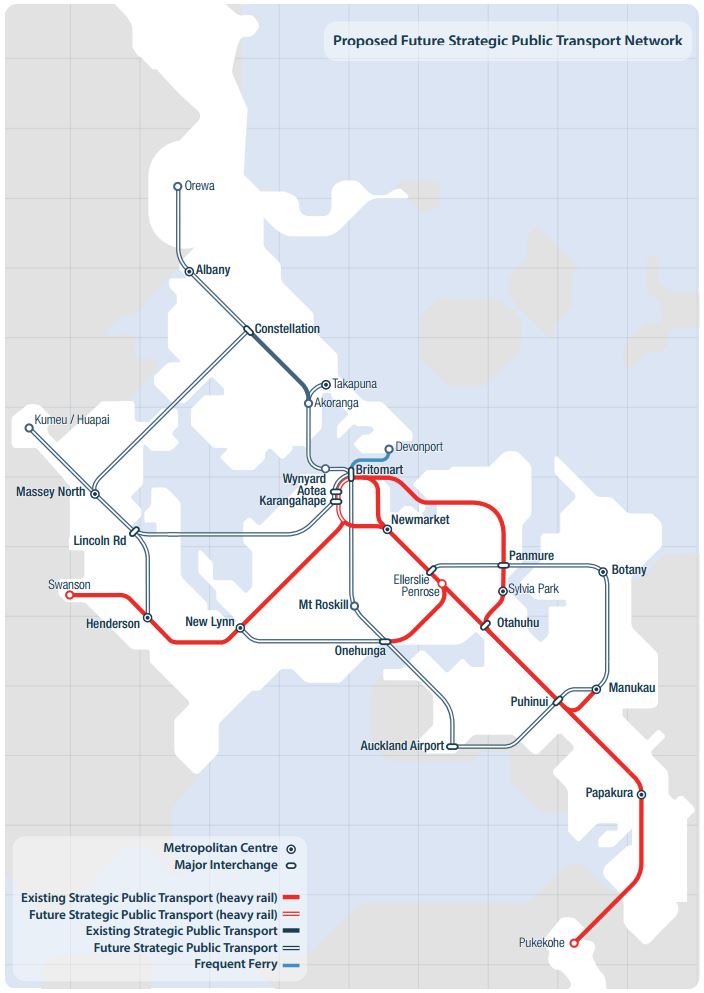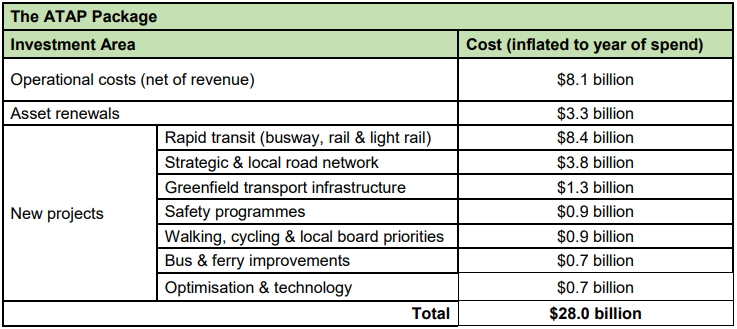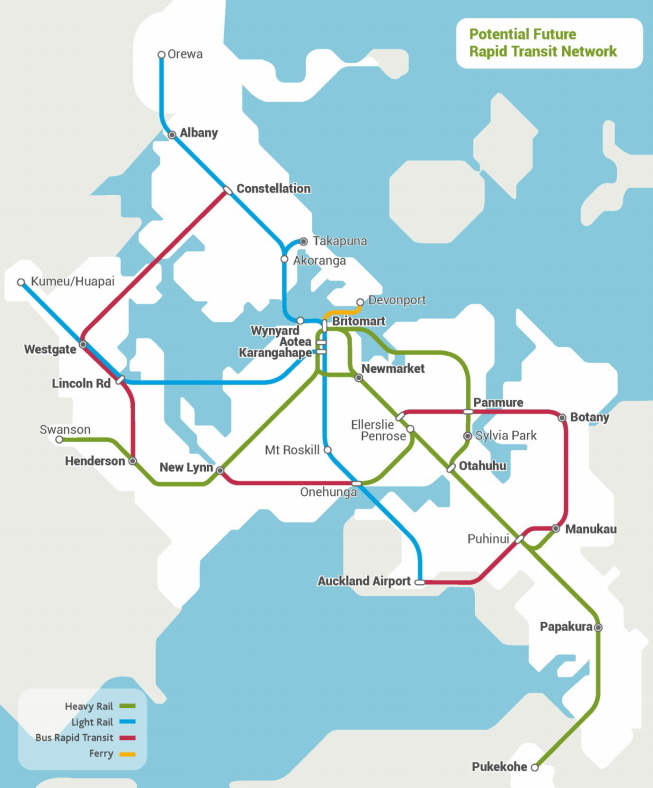Probably the most influential transport ‘project’ in Auckland over the last decade, maybe more hasn’t put a single shovel in the ground, and never will. That project is the Auckland Transport Alignment Project (ATAP).
ATAP has essentially become the agreement between the government and Auckland Council as to how the transport system will be developed and funded over a 30-year period, but with a focus primarily on the coming decade. It initially came about after the previous government finally recognised couldn’t keep publicly fighting the city and disagreeing on everything. That fighting was epitomised by the initial opposition to the City Rail Link but spread much further than that, for example they didn’t even agree on how fast or where the city would grow, an important input into deciding what transport projects need to be built. Some of this opposition also appeared to stem from some government ministers having a personal/political aversion to then Mayor Len Brown.
In a bid to address that, in 2015 it was announced the council and government would work together on what became ATAP. The first version was first published in 2016 and despite asking some of the wrong questions, ended up with largely the right answers. For example, for the first time the government admitted we couldn’t build our way out of congestion with more roads as well as agreeing that Auckland needed a Rapid Transit network.

But there were some holes in it, particularly around how much of a funding gap there was, and even at the time the first report was released it was clear the growth assumptions used were too low. As such, ATAP was revised and a 1.1 version was released less than a year later to address this and to reflect the priorities of new mayor Phil Goff. This brought forward projects such as Penlink, Mill Rd and the Puhinui interchange and associated busway. It also agreed we needed ‘mass transit’ on Dominion Rd within the decade.

After Labour came to power at the end of 2017, they wanted a new version to take into account their priorities as a government and ATAP 2.0 was released in April 2018. As well as putting greater focus on public transport, safety as well as walking and cycling – the latter of which was something completely missing from the first two versions, the critical thing ATAP 2.0 did was to see the government agree to fund the now $28 billion programme.
While the previous versions showed the high-level RTN, ATAP 2.0 took the RTN a step further by confirming modes and bringing forward implementation.
Now, the council and government are looking to revise ATAP once again and a few weeks ago the council endorsed a new Terms of Reference for it. The paper to the council lists the key reasons for this refresh:
- changes to the funding baseline due to the impacts of COVID-19 on existing revenue streams; any resulting economic stimulus packages introduced by central government; and the implications of the pre-COVID-19 New Zealand Upgrade Programme
- climate change and mode shift as increasingly important priorities for Auckland Council and central government that need to be better reflected in the transport package
- the need to provide strategic direction for upcoming statutory planning processes, such as the Long-term Plan (LTP) and Regional Land Transport Plan (RLTP), particularly for the last three years of the first decade (2028-31) which were not part of ATAP 2018
- the need to consider the transport investment needs of emerging brownfield and greenfield spatial priorities.
On the NZ Upgrade Programme, the paper notes there is now uncertainty on its impacts. In particular, both Penlink and Mill Rd were in the 2018 ATAP as being council/AT projects and that they would be part funded by the Regional Fuel Tax. The NZUP has seen them become fully government funded and delivered projects and that has freed up $1.6 billion within the decade and so it’s not clear if Auckland can then use that money to bring forward other projects not in the 10-year list.
The council agreed to endorse the draft Terms of Reference with one change – emphasis is mine
endorse the draft Terms of Reference for the Auckland Transport Alignment Project (ATAP) 2020 update, subject to the fourth bullet point of 4.1 being amended to the following “Improving the resilience and sustainability of the transport system, and significantly reducing the greenhouse gas emissions it generates”
For reference, here were all the priorities before the change above.
The paper notes:
Phase 1 of the update will focus in detail on the current first decade (2021-31) and is expected to be completed by August 2020. Phase 2 will focus on decades two and three (2031-51) at a more indicative level and will be completed at a later date.
That timing for the first stage is in part related to the election.
While some of it is kind of mentioned above, here are some of the things we think the next ATAP should focus on and address.
- The council beefing up the ToR about emissions is a good step but probably needs to go a little further and ensure every single project is viewed through a climate emergency lens. If a project doesn’t actively contribute to that priority, it shouldn’t be included.
- We need to achieve significant mode shift in Auckland with more people walking, cycling and using public transport. Last year our transport agencies combined to create a mode shift plan for Auckland. ATAP needs to not just consider that but embed it in ATAP. Like with emissions, if a project doesn’t actively contribute to mode shift, it should not be considered.
- Related to the points above, I would like to see ATAP take a reverse approach to planning, even if just as a comparison. The current BAU approach is to come up with a range of different packages and evaluate the impacts they have and then from that piece together the bits that perform the best. But the ‘best’ may still fall short of achieving what we need it to. So by a reverse approach I mean, they should set an emissions, mode share, safety goal etc and then work back from there. It would be interesting to see how different the projects on the list are.
- With ATAP being updated to reflect a post-Covid world financially, it should also include how we can capture some of the benefits experienced through this time, in particular the significant health benefits of more people using active modes which was also made possible by significantly reduced levels of traffic. Not to mention the alternative uses for our streets that became possible. Of note, during his press conference yesterday, Dr Ashley Bloomfield said we need more of this.
https://twitter.com/BikeAKL/status/1265577335211745280
- ATAP needs a proper and robust set of measures and targets. These targets should include emissions and mode shift as mentioned above.
- Finally given ATAP seems to be taking on an increasingly important role in Auckland’s planning, it would be good if ATAP, or a simplified version of it, could be made to be more digestible by the public. For example this is from Vancouver on their 10 year vision and is clear on what’s planned and where they’re at with it. While this may not be exactly the same as what ATAP is, it’s close.




 Processing...
Processing...
Measures and targets you say?
Good luck as Goff does not believe in them. He stripped them out of the Auckland Plan and despite constant words from Cr Darby they have never returned.
As for making the ATAP readable…..
Given the Supporting Growth Social Pin page is not user friendly the institutes could learn a lot on easy to read information
That’s disappointing. When did he did that?
* do that?
Hopefully it brings the focus back to easily the most important finding/project of ATAP – road pricing. It was shown to have hands down the greatest benefits compared to all other projects. Its very unfortunate that the government has allowed this project to drift and fall behind its programme dates.
+1000
This is tremendously important. It impacts so many things, including how useful many other projects are. It’s also an idea that now pretty much everyone across the political spectrum agrees is necessary.
Its also political suicide and will never be implemented. National are pretending they will but they will just keep delaying it. (Actually considering the whole point of road pricing is to free up roads for rich people to use, maybe National would implement it).
More like to free up the roads for those who need to use them in single occupancy vehicles (ie tradies with tools etc) being the whole point. as well as the other physical and mental health improvements for the population this refinement of policy could facilitate.
How do you define rich people?
“How do you define rich people?”
I don’t know, I am not setting the prices. In London the congestion charge was for very rich people (and rich tradies I guess).
Road pricing is where they take some land that we all own and some roads that we all paid for and allow the well off to use them for a cost much less than user pays but a bit more than the average Joe can afford.
Road pricing will be popular amongst freight and delivery companies, Jimbo. Covid gave them any confirmation they needed to see how lower traffic volumes benefit their companies, too.
Really good to see that Mainfreight voluntarily decided to return its wage subsidy after the business fared better than expected in lockdown.
I agree pricing’s important Matthew. But here’s a question:
“It was shown to have hands down the greatest benefits compared to all other projects” – on what measure?
Reducing the peak congestion?
Multiple levers need to be used, especially because there are multiple goals. Reducing the peak congestion does nothing to improve some other goals.
+1, having 4 lanes of traffic flying past schools at 830am is worse than 4 lanes of stationary traffic, but I bet any assessment won’t consider that as a disbenefit.
Yes the original ATAP looked ar peak congestion effects. Road pricing had more effect than all other projects combined by a long shot.
Agreed there are other goals. ATAP is/was mainly about big expensive projects, which were primarily aimed at capacity expansion and congestion reduction. Ie they are working on the same dimension as road pricing. So I dont think I am stretching things to come to that conclusion. And it would logically have a bigger impact on other goals than the other ATAP projects.
The main alternative “dimension” that I can see would be the effects of active mode projects where I would agree it is not obvious road pricing is better, because they are quite different qualitatively. But IIRC ATAP hasnt really focused on active modes projects.
As well as active modes, road diets, place making etc
ATAP has done its dash. As a name it no longer sounds new and important so they can’t dress up the same projects and sell them to us as an innovative solution if they keep using that name. But don’t despair. There will be an Englishman somewhere in the Council whose job is to think up important sounding acronyms who will come up with a new name for the same old stuff.
I propose SSPOBAD – Same Stuff, Pushed Out By A Decade.
That’s all ATAP really is anyway.
Lol.
When I was a kid we had a term for being served up yesterdays inedible dinner for dinner today: “Y.M.C.A.” – not the song or the organisation.
But rather it stood for: Yesterdays muck cooked again.
Sure sounds exactly what this is – YMCA.
Considering I attended a hush-hush “public consultation” [run by the Government likely MoT but never clarified] over road pricing options for Auckland back in 2006 where considerable details of various road pricing schemes were discussed and very roughly costed versus revenue. Showing a detail of thought had gone into it at a high level.
Not much has really changed – the same old arguments back and forth. No magic bullets have arrived since, nor likely too. Covid19 included.
Once thing is certain though: traffic has got much greater since 2006. And the costs of dealing with these same old, same old, issues even more so.
Yet, the road pricing elephant sits there in the corner being ignored by all and sundry.
The argument went then, we need workable alternatives to driving (i.e. working PT) before we price the roads. Or its a tax by another name.
Maybe that true, buts whats clear is that doing nothing, or doing the minimum to date hasn’t really worked. We’re no closer to a solution now than 2006.
What we do have in place since back in 2006, though is those motorway on-ramp lights. They’re now everywhere and they are a form of road pricing.
Maybe not explictly tolled mind you. But just the same.
They do “tax” road users now, and privilege those already on the motorway over those who are not. Meaning those who don’t want to pay the “road” toll are paying a time toll and are forced to wait in queues to use the “free” resource “their taxes” paid for.
So, yes you have untolled roads, but not in the way you probably assumed or envisaged.
The traffic itself (and the delays it causes) is the best form of road pricing. It eliminates low value trips without reserving the road for rich people. The cost is in time instead of in dollars; only those prepared to pay the current time cost will take the trip. And its already implemented here and around the world!
Jimbo – it’s terribly inefficient though, everyone has to come to a near halt before the disincentive starts to become effective.
It also assumes all people have the same relative ability to mitigate the need for those trips in the first place.
Do you have a bit of English in you, mfwic?
They could rename it Stuff we are doing regardless, Stuff we could do and Stuff we have no intention to ever do. The three lists are currently called decade 1, decade 2, and decade 3.
It’s great that Council are prioritising climate effects of transport programme now. But is this the same Council and Mayor that fought for Mill Rd as the no 1 regional priority in the Stimulus Programme? Even dragging half of it out of the 2nd decade into the absolute front row?
Do they even understand the role of transport in climate emissions, and the role of road building in creating ever more traffic? The next ATAP will have to be a revolutionary document compared to where they currently are. The conventional auto-first form these new sprawl-burbs needs to change for a start.
I look forward to the new thinking (yes; road pricing, low traffic neighbourhoods, existing street and road repurposing, etc etc)
Well cities having plans over the years that never came into fruition is nothing new. It’s what happens with most civic plans across the world. If anything; it’s unusual if even half of these plans ever come into actuality.
My criticism of ATAP from its first release was and still is the lack of a clear declaration that mode shift should be a clear aim of Auckland’s strategic transport planning. We need to move from 85-90% dependence on cars for getting around to a more balanced system – in the short term we should aim to boost PT from about 10% to 30% plus over the coming decades. As a result of submissions, the ATAP was amended slightly and does refer to mode shift, but only in passing. Because so much has been invested in roads over the last century we are locked into spending a lot of our future transport budget on maintaining them, but we should set ourselves some stretch goals leading to a more balanced set of transport modes and choices for users.
New book on GTFS – https://www.amazon.in/dp/B07QDCWHTP/ref=dp-kindle-redirect?_encoding=UTF8&btkr=1